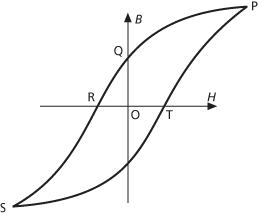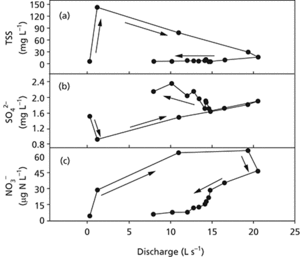A phenomenon in which two physical quantities are related in a manner that depends on whether one is increasing or decreasing in relation to the other.
The repeated measurement of stress against strain, with the stress first increasing and then decreasing, will produce for some specimens a graph that has the shape of a closed loop. This is known as a hysteresis cycle. The most familiar hysteresis cycle, however, is produced by plotting the magnetic flux density (B) within a ferromagnetic material against the applied magnetic field strength (H). If the material is initially unmagnetized at O it will reach saturation at P as H is increased. As the field is reduced and again increased the loop PQRSTP is formed (see graph). The area of this loop is proportional to the energy loss (hysteresis loss) occurring during the cycle. The value of B equal to OQ is called the remanance (or retentivity) and is the magnetic flux density remaining in the material after the saturating field has been reduced to zero. This is a measure of the tendency of the magnetic domain patterns (see magnetism) to remain distorted even after the distorting field has been removed. The value of H equal to OR is called the coercive force (or coercivity) and is the field strength required to reduce the remaining flux density to zero. It is a measure of the difficulty of restoring the symmetry of the domain patterns.

Hysteresis.
A lagging effect from an expected value due to a resistance such as friction. For example, in the control of processes, hysteresis is where there is a change in signal before a move in a valve.
A delay in the change of an observed effect in response to a change in the mechanism producing the effect. The best-known example of hysteresis is magnetic hysteresis.
The impact of its history on a physical system. The future development of the system depends on its history, for its progress is determined by the direction in which the reaction is occurring. It is normally described by a bivariate plot in which the value of one variable is dependent on whether the other variable is increasing or decreasing. For example, when plotting the relationships between solute concentrations and river discharge during storm events, very different solute concentrations are measured at the same discharge on the rising and falling limbs of the storm hydrograph.

Hysteresis
In economics, the property of a dynamic system to retain a memory or lagging effect in which the order of previous events can influence the order of subsequent events. If a system with hysteresis that is initially in equilibrium is subjected to a shock, its new equilibrium position depends on what happens during the process of dynamic adjustment (the path dependence property). In behavioural economics, when the disutility from a loss is greater than the utility from an equal gain, the utility of a person going through a cycle of gaining and losing exhibits hysteresis: after subsequent events of a gain and a loss of an item they are worse off than if they had never received the initial gain.
- Ch’ing dynasty
- CI
- Ciano, Count Galeazzo (1903–44)
- Cibola Flight Experiment Satellite
- cicada
- CICERO
- Cicero, Marcus Tullius (106–43)
- CICS
- CID
- Cid Campeador
- CIDNP
- CIE
- CIE colour model
- CIELAB
- Cieszkowski, August von (1814–94)
- c.i.f.
- c.i.f. pricing
- cilia
- ciliary body
- Washington, George (1732–99)
- wash load
- Washoe process
- wash-out period
- washover delta
- washover fan